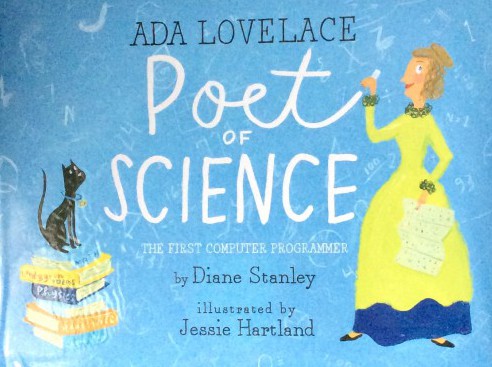Inspiring Young Readers
 posted on 17 Nov 2017
posted on 17 Nov 2017
Ada Lovelace Poet of Science by Diane Stanley, illustrated by Jessie Hartland
When we staggered home from Chicago in the summer with a suitcase full of great children’s non-fiction titles, we published on article on this site which said that it was about time the British non-fiction publishers got into the groove and started spreading their net a bit wider. Our gripe was that there are plenty of fabulous books about nature, science and all things ‘natural’ but when it came to politics and social history we lagged behind badly.
Well, maybe there are signs that things are really starting to change because we’re beginning to see many more books that can challenge the easy access children have in finding out information from the internet. This one is a very good example because I was first drawn in by the intriguing title and the very jolly looking picture of a woman dressed in period costume on the cover who was presumably Ada Lovelace. How could she be described as ‘a poet of science’ and did she really have an influence on computer programming such a long time ago? Like many people who have studied English, I knew that she was the daughter of Lord Byron, but other than that association I was pretty ignorant of her life and significance.

The story begins with a double page spread of a wintry night time scene in blues, black, grey and white with young Ada, wearing a bright red dress in the right hand corner. She is inside what looks like a grand house, presumably looking out of the window. On the turn of the page we quickly learn that she is a very imaginative girl who has already put her ideas into action and designed a flying machine. Once that project is complete, she moves onto building a steam- powered flying horse so she is clearly a girl who is bubbling with exciting ideas, rather like her father who is described as ‘a worldwide celebrity, the rock star of his time’. The marriage between him and Ada’s mother only lasted a year and Ada never knew him but the story suggests that she inherited his creative talents. Lady Byron on the other hand was interested in mathematics and science and so encouraged her daughter with what is described as a ‘world-class scientific education’. As a member of the aristocracy she had plenty of funds at her disposal and, because she loved machines, she was able to travel the world to see the new technologies in factories including the first mechanical loom invented by a Frenchman, Joseph Marie Jacquard.


This experience inspired her to look at how punched cards could be used to direct other machines beyond the textile industry. The disadvantage of being rich and the daughter of a celebrity was that she was obliged to spent time at many tedious parties, but this also gave her a social connection to Charles Babbage, the famous inventor and mathematician. Through him she met other important stars like Charles Dickens and Charles Darwin, people who ‘talked about important things: astronomy and politics, literature and art, and the latest engineering marvels’. Despite her many talents, her mother insisted on a conventional marriage for her daughter and thus she become Mrs Lovelace with three young children by the age of twenty four:
‘But she hadn’t lost sight of her dream, just postponed it’

She goes on to work collaboratively with Babbage on The Analytical Engine, his ground- breaking influential invention that could run all kinds of mathematical calculations.
The rather quirky illustrations by Jessie Hartland add pleasingly distinctive character to this interesting story. I like the variety of the layout of different pages with some parts of the book flooded with colourful detail set against a range of coloured backgrounds and others using a storyboard effect. The Chicago Tribune explains that she ‘deftly portrays in both word and drawing the awkward grace, the passionate personality, and the spunky gusto of her subject’. I recommend that you read and enjoy this upbeat, well designed picture book that conveys a strong message about the often neglected emphasis of the contribution of women to the history of ideas.
Karen Argent
November 2017

